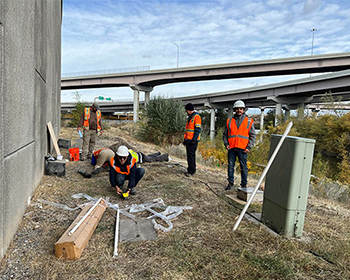Earthquake Data Lead to Better Seismic Models for Infrastructure Design
Posted: Jul 3, 2024
 Researchers at Utah State University are using data collected during a 2020 earthquake near Salt Lake City to help improve models used to design earthquake resistant transportation infrastructure. The earthquake was recorded by a unique arrangement of seismometers, called a downhole array, at the intersection of I-15 and I-80. While the instrumentation failed to record the main shock of the earthquake, it recorded several aftershocks. These aftershocks were used to help calibrate numerical ground response analyses aimed at predicting the site-specific amplification of seismic waves as they traveled out of bedrock and up through the soft soils.
Researchers at Utah State University are using data collected during a 2020 earthquake near Salt Lake City to help improve models used to design earthquake resistant transportation infrastructure. The earthquake was recorded by a unique arrangement of seismometers, called a downhole array, at the intersection of I-15 and I-80. While the instrumentation failed to record the main shock of the earthquake, it recorded several aftershocks. These aftershocks were used to help calibrate numerical ground response analyses aimed at predicting the site-specific amplification of seismic waves as they traveled out of bedrock and up through the soft soils.
Large earthquakes have historically caused significant damage to transportation infrastructure. Thus, engineers must use predictive models to account for potential seismic forces in infrastructure design. MPC research at Utah State University illustrates that models for predicting seismic ground response still need improvement so that transportation infrastructure is designed to be efficient and safe.
Brady Cox, Ph.D.
Utah State University